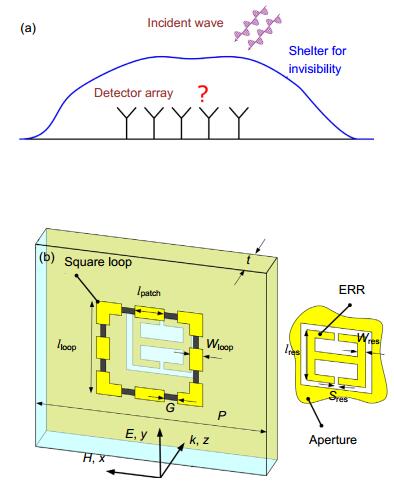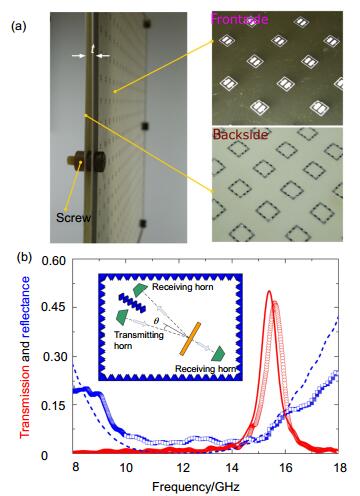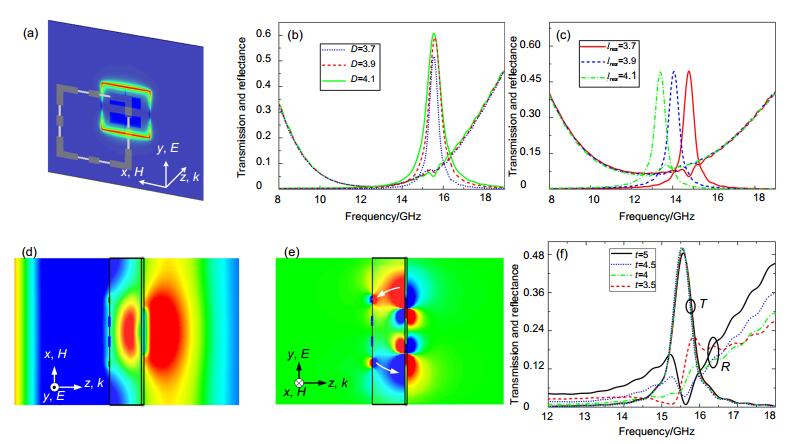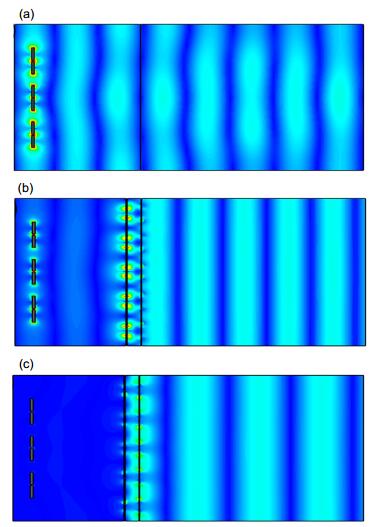-
Abstract:
A microwave metamaterial shelter with an electromagnetic narrow window over a broad absorption spectrum is experimentally demonstrated by resorting to conventional impedance-matching theory and metamaterial resonance. This device consists of a broad absorber and an embedded electric resonator, and has the ability of permitting one to "see" surroundings but not to be readily sensed by outside detectors. The origin is verified to be a dipole oscillation excited in absorbing region which can induce selective re-emission of the captured energy towards the enclosed space. The performance of "observing without being perceived" is numerically presented.

-
Key words:
- metamaterial /
- cloak /
- absorption
-

Abstract: Hiding a detector is not a nascent topic yet, which has many fascinating and important applications in both civil and military areas. In antenna fields, microwave engineers often use an absorbing or frequency-selective layer to construct a radome in order to reduce the radar-echo of inner antenna. However, the absorbed or redirected incident wave is out of the operating band of the antenna, thus having no consequential help on the reduction of antenna's in-band echo. As a result, it is a challenge to reduce the antenna's in-band echo, which has attracted much attention during the last 50 years. In this paper, we designed and demonstrated a low-echo metamaterial (MM) shelter with in-band electromagnetic narrow window. The unit-cell of the MM shelter is composed of two basic elements: a metallic square-loop with two small gaps in each side, and an electric-resonant-ring (ERR) embedded into a sub-wavelength aperture. Eight chip-resistors are respectively inserted into the gaps of square-loop to provide necessary lossy source. When the electromagnetic wave impinges the square-loop side, most of the energy would be absorbed by these chip-resistors, provided that the oscillating frequency does not coincide with the resonant frequencies of the ERR. At the resonant frequency of the ERR, the interplay of the transmission and absorption may greatly increase the transmitted energy through the aperture decorated with ERR. By introducing a selective re-emission mechanism of the energy captured by an absorbing layer, we observe that at least half of energy can pass through the narrow window located into the absorption band, and the broad low-echo feature is not influenced. The performance of the MM shelter and its ability for shading electromagnetic receiver is demonstrated by carrying out a numerical experiment, including three main portions: a dipole array acting as a signal receiver, a remote point source with tunable amplitude utilized to model the far-field excitation of a signal source, and an inserted MM shelter. This device is believed to be suitable for the in-band scattering reduction of antenna which is especially designed to work in the receiving mode. We expect that, the concept and design reported here will influence the future design of electromagnetic absorber and radome, generating a new research hot topic in electromagnetic invisibility field. Our design may be applied in wireless local area network to cancel additional multi-paths, or signal degradation because it can effectively absorb useless signals without significantly attenuating mobile phone signals.
-

-
Figure 1. (a) Detector array is out-of-function when covered by electromagnetic cloak or conventional absorber. (b) Schematic drawings of a meta-material shelter with an in-band electromagnetic transparent window. The black sticks represent chip-resistors. The propagation and polarization directions are indicated in (b) with axes and respective dimension notations are listed correspondingly.
Figure 2. (a) Photographs of the MM shelter (Left), ERR layer (Right and up), and square-loop layer (Right and down) with chip-resistor. (b) Simulated and measured T(ω) (simulation: solid line, Measurement: circle, red) and R(ω) (simulation: dash line, measurement: square, blue). The inset picture shows the method of the sample measurement. All equipments are located into an environment decorated with radar absorbing materials. The normal R(ω) is approximated by the oblique one with a small angle (θ=5 degree). The coupling between transmitting and receiving horns is obstructed by placing high absorption materials between them.
Figure 3. (a) Electric energy density at the peak frequency, the eight sticks (white) denote the inserted chip-resistors, the propagation direction is also presented. (b) and (c) Spectra with changing parameters lres and D, respectively. (d) and (e) Distributions of y-component and z-component of electric field, respectively. (f) Spectra with increasing thickness t of the dielectric layer. (e) The arrows marked in the internal region indicate the direction of electric flux-lines. Red and blue colors indicate reverse phase distributions in (d) and (e).
Figure 4. Demonstration of the ability of the proposed MM shelter for hiding an array of electromagnetic receiver. (a) and (b) Distribution of the wavefront in the simulated space without and with the proposed MM shelter at 15.4 GHz, respectively. (c) Distribution of the wavefront with the proposed invisibility 13 GHz. The incident wave transmits from right to left.
-
[1] Salisbury W W. Absorbent body for electromagnetic waves: US, 2599944[P]. 1952.
[2] Luo Xiangang. Principles of electromagnetic waves in metasurfaces[J]. Science China Physics, Mechanics & Astronomy, 2015, 58(9): 594201. https://link.springer.com/article/10.1007/s11433-015-5688-1
[3] Luo Xiangang, Pu Mingbo, Ma Xiaoliang, et al. Taming the electromagnetic boundaries via metasurfaces: from theory and fabrication to functional devices[J]. International Journal of Antennas and Propagation, 2015, 2015: 204127.
[4] Pendry J B, Schurig D, Smith D R. Controlling electromagnetic fields[J]. Science, 2006, 312(5781): 1780-1782. doi: 10.1126/science.1125907
[5] Leonhardt U. Optical conformal mapping[J]. Science, 2006, 312(5781): 1777-1780. doi: 10.1126/science.1126493
[6] Swandic J R. Bandwidth limits and other considerations for monostatic RCS reduction by virtual Shaping[R]. West Bethesda: Naval Surface Warfare Center, Carderock Division, 2004.
[7] Pu Mingbo, Zhao Zeyu, Wang Yanqin, et al. Spatially and spectrally engineered spin-orbit interaction for achromatic virtual shaping[J]. Scientific Reports, 2015, 5: 9822. doi: 10.1038/srep09822
[8] Schurig D, Mock J J, Justice B J, et al. Metamaterial electromagnetic cloak at microwave frequencies[J]. Science, 2006, 314(5801): 977-980. doi: 10.1126/science.1133628
[9] Liang Dachuan, Gu Jianqiang, Han Jiaguang, et al. Robust large dimension terahertz cloaking[J]. Advanced Materials, 2012, 24(7): 916-921. doi: 10.1002/adma.201103890
[10] Valentine J, Li J, Zentgraf T, et al. An optical cloak made of dielectrics[J]. Nature Materials, 2009, 8(7): 568-571. doi: 10.1038/nmat2461
[11] Ni Xingjie, Wong Z J, Mrejen M, et al. An ultrathin invisibility skin cloak for visible light[J]. Science, 2015, 349(6254): 1310-1314. doi: 10.1126/science.aac9411
[12] Bliokh K Y, Rodríguez-Fortuño F J, Nori F, et al. Spin-orbit interactions of light[J]. Nature Photonics, 2015, 9(12): 796-808. doi: 10.1038/nphoton.2015.201
[13] Pu Mingbo, Li Xiong, Ma Xiaoliang, et al. Catenary optics for achromatic generation of perfect optical angular momentum[J]. Science Advances, 2015, 1(9): e1500396. doi: 10.1126/sciadv.1500396
[14] Tang Dongliang, Wang Changtao, Zhao Zeyu, et al. Ultrabroadband superoscillatory lens composed by plasmonic metasurfaces for subdiffraction light focusing[J]. Laser & Photonics Reviews, 2015, 9(6): 713-719. https://www.onlinelibrary.wiley.com/doi/10.1002/lpor.201500182
[15] Ma Xiaoliang, Pu Mingbo, Li Xiong, et al. A planar chiral meta-surface for optical vortex generation and focusing[J]. Scientific Reports, 2015, 5: 10365. doi: 10.1038/srep10365
[16] Knott E F, Tulley M T, Shaeffer J F. Radar Cross Section[M]. 2nd ed. Raleigh: SciTech Publishing, 2004.
[17] Alù A, Engheta N. Achieving transparency with plasmonic and metamaterial coatings[J]. Physical Review E, 2005, 72(1): 016623. doi: 10.1103/PhysRevE.72.016623
[18] Alù A, Engheta N. Cloaking a sensor[J]. Physical Review Letters, 2009, 102(23): 233901. doi: 10.1103/PhysRevLett.102.233901
[19] Veselago V G. The electrodynamics of substances with simultaneously negative values of ε and μ[J]. Soviet Physics Uspekhi, 1968, 10(4): 509-514. doi: 10.1070/PU1968v010n04ABEH003699
[20] Smith D R, Padilla W J, Vier D C, et al. Composite medium with simultaneously negative permeability and permittivity[J]. Physical Review Letters, 2000, 84(18): 4184-4187. doi: 10.1103/PhysRevLett.84.4184
[21] Lier E, Werner D H, Scarborough C P, et al. An octave-bandwidth negligible-loss radiofrequency metamaterial[J]. Nature Materials, 2011, 10(3): 216-222. doi: 10.1038/nmat2950
[22] Feng Qin, Pu Mingbo, Hu Chenggang, et al. Engineering the dispersion of metamaterial surface for broadband infrared absorption[J]. Optics Letters, 2012, 37(11): 2133-2135. doi: 10.1364/OL.37.002133
[23] Pu Mingbo, Chen Po, Wang Yanqin, et al. Anisotropic meta-mirror for achromatic electromagnetic polarization manipulation[J]. Applied Physics Letters, 2013, 102(13): 131906. doi: 10.1063/1.4799162
[24] Grady N K, Heyes J E, Chowdhury D R, et al. Terahertz metamaterials for linear polarization conversion and anomalous refraction[J]. Science, 2013, 340(6138): 1304-1307. doi: 10.1126/science.1235399
[25] Guo Yinghui, Yan Lianshan, Pan Wei, et al. Achromatic polarization manipulation by dispersion management of anisotropic meta-mirror with dual-metasurface[J]. Optics Express, 2015, 23(21): 27566-27575. doi: 10.1364/OE.23.027566
[26] Pu Mingbo, Hu Chenggang, Wang Min, et al. Design principles for infrared wide-angle perfect absorber based on plasmonic structure[J]. Optics Express, 2011, 19(18): 17413-17420. doi: 10.1364/OE.19.017413
[27] Pu Mingbo, Feng Qin, Wang Min, et al. Ultrathin broadband nearly perfect absorber with symmetrical coherent illumination[J]. Optics Express, 2012, 20(3): 2246-2254. doi: 10.1364/OE.20.002246
[28] Watts C M, Liu Xianliang, Padilla W J. Metamaterial electromagnetic wave absorbers[J]. Advanced Materials, 2012, 24(23): OP98-OP120. https://www.researchgate.net/publication/225043909_Metamaterial_Electromagnetic_Wave_Absorbers
[29] Ebbesen T W, Lezec H J, Ghaemi H F, et al. Extraordinary optical transmission through sub-wavelength hole arrays[J]. Nature, 1998, 391(6668): 667-669. doi: 10.1038/35570
[30] Munk B A. Frequency Selective Surfaces: Theory and Design[M]. New York: Wiley, 2000.
[31] Yin Xiaogang, Huang Chengping, Wang Qianjin, et al. Transmission resonance in a composite plasmonic structure[J]. Physical Review B, 2009, 79(15): 153404. doi: 10.1103/PhysRevB.79.153404
-


 E-mail Alert
E-mail Alert RSS
RSS

 下载:
下载:






